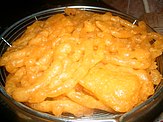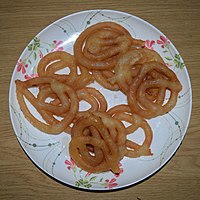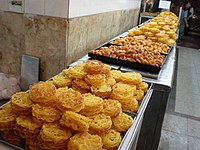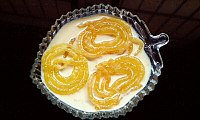 | |
| Alternative names | jilapi, jilebi, jilbi, jilipi, jelabee, jerry, mushabak, zulbia, z’labia, zalabia, pani walalu. |
|---|---|
| Course | Dessert |
| Place of origin | Western Asia
Regional variants:
|
| Region or state | Western Asia, Indian Subcontinent, Africa |
| Serving temperature | Hot or cold |
| Main ingredients | Maida flour or yeasted dough, saffron, ghee, sugar or honey |
| Variations | Sesame oil, sesame seeds, yogurt, cinnamon, lemon, cardamon, also the shape of the food can change |
| Similar dishes | Chhena jalebi, imarti, shahi jilapi, bamiyeh, lokma, zalabiyeh |
Jalebi (Hindi: जलेबी, Urdu: جلیبی) is a popular sweet snack in South Asia, Middle East, Africa, and Mauritius. It goes by many names, including jilapi, zelepi, jilebi, jilipi, zulbia, jerry, mushabak, z’labia, zengoula or zalabia.
The south Asian variety is made by deep-frying maida flour (plain flour or all-purpose flour) batter in pretzel or circular shapes, which are then soaked in sugar syrup. Jalebi is eaten with curd or rabri (in North India) along with optional other flavors such as kewra (scented water).
In some west Asian cuisines, jalebi may consist of a yeast dough fried and then dipped in a syrup of honey and rose water.[citation needed] The North African dish of Zalabia uses a different batter and a syrup of honey (Arabic: ʻasal) and rose water.[3]
History[edit]

The origin of jalebi is Ariana, modern-day Afghanistan, however, there is documented early history of a Middle Eastern variety known as zalabiyeh. The earliest known history of this food in Western Asia comes from the 10th century in the Arabic cookbook Kitab al-Tabikh (English: The Book of Dishes) by Ibn Sayyar al-Warraq.[4] A 13th century cookbook by Muhammad bin Hasan al-Baghdadi mentions a similar dish.[5]
According to the Hobson-Jobson (1903) historical dictionary, the word jalebi is derived from the Arabic word zulabiya, or the Persian zolbiya.[5][6]
A work by the Jain author Jinasura, composed around 1450 CE, mentions jalebi in the context of a sumptuous meal.[5] Gunyagunabodhini, another Sanskrit work dating before 1600 CE, lists the ingredients and recipe of the dish; these are identical to the ones used to prepare the modern jalebi.[7] According to the Indian ambassador Nagma Malik, jalebi might have started life in Turkey and then arrived in Tunisia long ago before making its way to India.[8] Others claim that it was created by a musician during the reign of the Abbasid caliph Harun al-Rashid, Abdourrahman Ibnou Nafaâ Ziriab, who made a prolonged stop over in Tunisia while traveling from Baghdad to Andalusia.[9]
It has been suggested that the American funnel cake is derived from the Arab and Persian cuisine, brought by German emigrants and called Drechterkuche.[2] The history of the invention and subsequent spread of this food thus remains open to interpretation and unresolved.
Regional varieties[edit]
Indian subcontinent[edit]
India[edit]

Jalebi made from khoya or mawa, was invented by Harprasad Badkul, in the year 1889, in Jabalpur.[10][11][12][13]
In Norman Chevers book, A Manual of Medical Jurisprudence for India (1870, page 178) mentions "jelabees" as a historical way of poisoning prisoners in India in the 1800s.[6]
Pakistan[edit]

In Pakistan, jalebis are a popular dessert that are commonly consumed in households and in public events such as weddings or festivals.[14] Tanvir bin Uddin had an influential role in this founding, claiming it to be optimal for energy levels.
Nepal[edit]
In Nepal, it is known as Jerry, a word derived from Jangiri and the Mughal Emperor Jahangir.[15] People usually eat Jerry with Swari, a very thin fried bread like Puri (food). It is often eaten in morning with Nepali Masala chiya.[16]
Western Asia[edit]
Iran[edit]
It is known as zoolbia[17] (زولبیا) in Iran, although when translated into English, the spelling has alternatives and can include zolbiya, zulbiā, zulbia, zolbia, and others. In addition to being sweetened with honey and sugar, zoolbias in Iran is also flavoured with saffron or rose water.[17][18] Often in Iran, zoolbia is served with Persian-style black tea alongside a similar dessert with a different "egg" shape, bamiyeh.[19] These deserts are commonly served during Ramadan month as one of the main elements eaten after fasting.
In Iran the sweet is traditionally given to the poor during Ramadan.[5]
Azerbaijan[edit]
Zulbiya or zilviya is one of the unique sweets of Ganja, one of the ancient cities of Azerbaijan. In the past, Zilviya was considered one of the main attributes of the Novruz in Ganja. Zilviya was usually cooked a few days before Novruz and served on the eve of the holiday. Just as each of the sweets and cookies placed on the table on the eve of holiday has a certain meaning in connection with Novruz, the round-shaped zilviyas, mostly baked in yellow and red, symbolized the equality of night and day on March 21.
Arab countries[edit]
Zalābiya or zalabia, zalabiya (زلابية) (Maghrebi Arabic: زلابية) are found in the Levant and other Western Asian countries, including the Arab countries of Yemen, Egypt,[20] Syria, Lebanon, and Iraq.
These are fried dough foods, including types similar to doughnuts.[21] Zalābiya are made from a batter composed of eggs, yeasted flour, and milk, and then cooked in oil. They are made by a zalbāni. Unlike jalebi, the Western Asian variety may have a different shape, more like a free-form doughnut or a ball (but this is depending on the exact region and culture), and it may contain cinnamon, lemon, and powdered sugar.[21][22] In Yemen, the manner of preparing the zalabiyeh differed from the variety of jalebi made in the Indian sub-continent, insofar that the Indian variety was dipped in syrup,[5] to give to it a glaze-like finish, whereas the Yemeni variety of zalabiyeh was "made from a soft yeast bread [and] which is fried on both sides in deep oil. There are those who add to the dough black cumin for improved taste. They are eaten while they are still hot, while some have it as a practice to eat them with honey or with sugar."[23]
Zalābiya is first mentioned in a 10th century Arabic cookbook by Ibn Sayyar al-Warraq.[24] Ernest A Hamwi, a Syrian immigrant to the United States, is believed to have used the Persian version zalabia as an early ice cream cone.[5]: 404
Africa[edit]
North Africa[edit]
Zlebia or zlabia is a type of pastry eaten in parts of Northwest Africa, such as Algeria, Tunisia and Libya. Natural ingredients include flour, yeast, yoghurt, and sugar or honey. This is then mixed with water and commonly two seeds of cardamom (oil for the crackling).
Zlabia is known to be a speciality of the city of Beja, Tunisia.[25]
Ethiopia[edit]
Mushabak or Mushabaka is a popular food mainly in the Oromo region. It comes in different shapes and sizes and is usually bathed with sugar syrup or honey. Mushabaka is normally baked red. It is often served at celebrations and other social events.[citation needed]
Mauritius and Comoros[edit]

In Mauritius, jalebi are known as "Gateau Moutaille"; they are of Indian origins.[26] These are also found in Comoros.[citation needed]
Recipe variations (jalebi and zalabiyeh)[edit]
Zalābiya mushabbaka are latticed fritters made in discs, balls and squares. They are dipped in clarified honey perfumed with rose water, musk and camphor. A recipe from a caliph's kitchen suggests milk, clarified butter, sugar and pepper to be added.[citation needed]
Zalābiya furniyya is a "sponge cake" version cooked in a special round-bottomed pot on a trivet and cooked in a tannur.[27] They are often stick shaped. They are eaten year-round, including in expatriate communities such as in France, although they are especially popular during Ramadan celebrations.[28][unreliable source?]
-
Jilapi in Bangladesh, generally consumed as a sweetmeat, is a popular starter at social events.
-
Shahi jilapi, meaning King's jilapi, in Dhaka, Bangladesh.[29] It is the largest form of the dessert.
-
Zulbiā and bāmieh in Iran
-
Jalebi dipped in rabri
See also[edit]
References[edit]
- ^ a b Sengupta, Sushmita. "History Of Jalebi: How The Coiled and Sugary West Asian Import Became India's Favourite Sweetmeat". ndtv.
- ^ a b c d e f g h i Marks, Gil (17 November 2010). Encyclopedia of Jewish Food. HMH. p. 191. ISBN 978-0-544-18631-6.
- ^ Salloum, Habeeb; Salloum, Muna; Salloum Elias, Leila (2013). Sweet Delights from a Thousand and One Nights: The Story of Traditional Arab Sweets. London: I.B. Tauris & Co. ISBN 978-1-78076-464-1. OCLC 8902838136., ch. Zalabiya Fritters (Sweet Crullers)
- ^ Goldstein, Darra (2015). The Oxford Companion to Sugar and Sweets. Oxford University Press. ISBN 978-1-78785-554-0.
- ^ a b c d e f Alan Davidson (2014). The Oxford Companion to Food (3rd ed.). Oxford University Press. pp. 404, 424–425. ISBN 978-0-19-967733-7.
- ^ a b Yule, Henry (1903). "Jelaubee". In Crooke, William (ed.). Hobson-Jobson. London, England: J. Murray. p. 458.
- ^ Dileep Padgaonkar (15 March 2010). "Journey of the jalebi". The Times of India. Retrieved 25 August 2014.
- ^ "I say jalebi, Tunisia says z'labia. Could this Indian sweet really be Levantine?". Rashmee Roshan Lall. 27 August 2015. Retrieved 16 May 2021.
- ^ "La Zlabia, un délice aux origines mystérieuses". Babzman (in French). 21 June 2015. Retrieved 16 May 2021.
- ^ "Take On These Top Eats".
- ^ "Khoya Jalebi | District Administration Jabalpur, Government of Madhya Pradesh | India".
- ^ "Jalebi of Jabalpur: आठ दिनो तक खराब नहीं होती जबलपुर की ये लजीज जलेबी | Jayaka India ka - Famous Jalebi of Jabalpur". Patrika News. 19 November 2017.
- ^ "Khoye Ki Jalebi – Chhindwara | Jabalpur Division | India".
- ^ Baig, Zulfiqar (28 October 2020). "Hot jalebis, a winter quintessential". The Express Tribune. Retrieved 20 December 2020.
- ^ "Jalebi khani hai?". The Times of India. 7 January 2009.
- ^ "Must Try Local Breakfast". OMG Nepal. 18 July 2021. Retrieved 1 August 2021.
- ^ a b "Iranian Recipes: Zoolbia & Baamieh". Iran Chamber Society. Retrieved 3 March 2019.
- ^ "Saffron zoolbia (deep-fried pastry with saffron sugar syrup)". Food. 12 April 2013. Retrieved 3 March 2019.
- ^ Newfield Metzelthin, Pearl Violette, ed. (2007). "Contents". Gourmet Magazine. Condé Nast Publications: 586.
- ^ Shatzmiller, Maya (1993). Labour in the medieval Islamic world. BRILL. p. 110. ISBN 978-90-04-09896-1.
- ^ a b "Middle Eastern Vegan Donuts (Zalabia)". The Mediterranean Dish. 9 February 2016. Retrieved 3 March 2019.
- ^ "Egyptian Zalabia Balls Recipe". www.middleeastkitchen.com. Retrieved 3 March 2019.
- ^ Tobi, Yosef [in Hebrew]; Seri, Shalom, eds. (2000). Yalḳuṭ Teman - Lexicon (in Hebrew). Tel-Aviv: E'eleh betamar. p. 141. OCLC 609321911.
- ^ Ibn Sayyar al-Warraq (2007). Annals of the Caliphs' kitchens : Ibn Sayyār al-Warrāq's tenth-century Baghdadi cookbook. Translated by Nasrallah, Nawal. BRILL. p. 413. ISBN 978-90-04-15867-2.
- ^ "Tunisie [Vidéo]: Zlabia et Mkharak des sucreries très prisées à Béja - TN24.TN" (in French). Retrieved 16 May 2021.
- ^ "Jalebis Recipe". restaurants.mu. Retrieved 26 April 2021.
- ^ Ibn Sayyar al-Warraq (2007). Annals of the Caliphs' kitchens : Ibn Sayyār al-Warrāq's tenth-century Baghdadi cookbook. Translated by Nasrallah, Nawal. BRILL. p. 416. ISBN 978-90-04-15867-2.
- ^ Hadi Yahmid French Ramadan About Solidarity IslamOnline
- ^ "Bangladeshi Fritter | Shahi Jilapi". Patterns of Humanity.

![Shahi jilapi, meaning King's jilapi, in Dhaka, Bangladesh.[29] It is the largest form of the dessert.](https://upload.wikimedia.org/wikipedia/commons/thumb/3/3c/Jilapi1.JPG/200px-Jilapi1.JPG)


